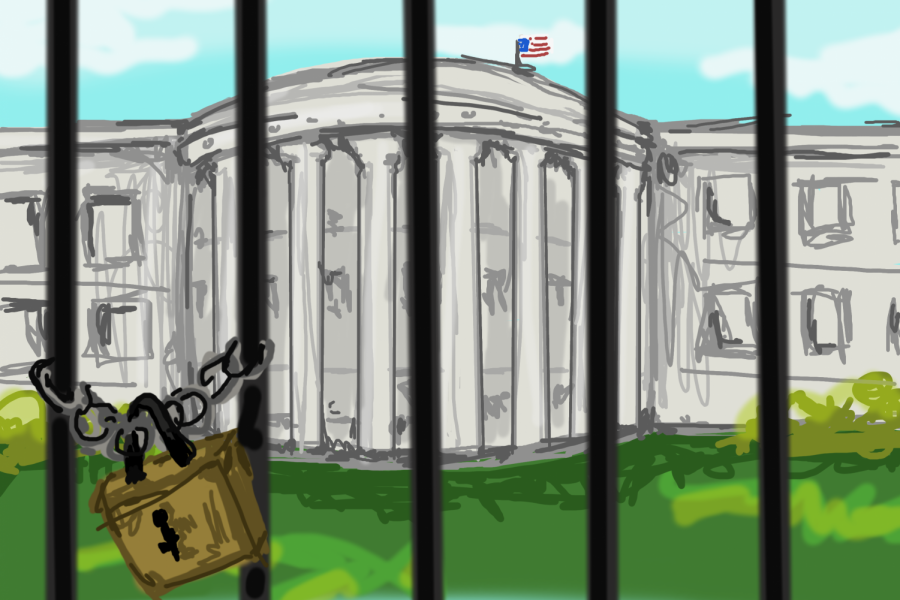The Longest Government Shutdown in US History: Could it Happen Again?
January 28, 2019
On December 21, 2018, the longest government shutdown in United States history began, and ran for 35 days. It broke the previous record of 21 days, set during the administration of former President Bill Clinton.
A government shutdown occurs when non-essential government programs are forced to close. This is a result of Congress and the President being unable to come to an agreement to provide funds through the budget process. Each fiscal year, Congress votes on a government spending bill to fund all federal programs. But if Congress cannot pass this bill, the whole budget process breaks down, and the government may be unfunded, leading to full or partial closures of government agencies.
The government shutdown was precipitated by the dispute concerning border security and immigration. President Donald Trump proposed the construction of a wall along the border between the United States and Mexico, costing $5.7 billion dollars. This proposal was aiming to combat the alleged crisis of immigrants seeking asylum in America. The erection of a border wall would halt 144,000 immigrants, according to the Trump administration. This effort to construct a border wall was one of Trump’s most prominent campaign promises. A few of Trump’s primary goals were to reinvigorate the US economy and bring jobs back to American citizens. With a reduction of immigrants entering the US, there would be more job availability for US citizens, the administration claims. Another reason for the construction of a border wall, according to proponents, would be to reduce the number of narcotics brought into the country and also reduce the number of violent crimes. Democrats opposed the wall for many reasons. They believe that even with a barrier, immigrants would still make their way into the country, which does not justify the high cost for its construction. The wall is also stated to symbolize discrimination and the idea that Americans look down upon other people.
During this period of absent party collaboration, Democrats and Republican vehemently disagreed on the topic of immigration and specifically the necessity and efficacy of a border wall. Leading up to the Dec. 21 deadline, Congress passed a spending bill that fully funded the government, including $1.3 billion for general border security, but they did not directly include money for a border wall. Following the passing of this bill, Trump stated he would veto the bill. The then Republican controlled House proceeded to pass another bill with $5.7 billion dollars allocated for the wall. Following the transition from a Republican House majority to a Democratic majority, a bill was passed to reopen the government but does not include funding for the wall. The Senate, which is controlled by a Republican majority, backed Trump’s demands and would not vote on the bill. Democrats refused to fund any construction of a border wall in opposition to Trump’s policies on immigration and against the President himself.
Three-quarters of the government programs were still funded because they were deemed “essential,” but all remaining programs were either fully or partially shut down. Departments that remained open were the departments of Labor, Energy, Defense, Health and Human Services, and Education. In addition, law and enforcement officers, Transportation Security Administration, firefighters, and “mandatory spending” programs of Social Security, Medicare, and Medicaid are considered vital and remained open. Closed departments included the Department of Treasury, Agriculture, State, Housing and Urban Development, Transportation, and Justice.
During the shutdown, around 800,000 government employees did not receive a paycheck, 380,000 employees were furloughed, and another 420,000 people were working without pay; and both “essential” and “nonessential” employees are not getting paid. There were also another 500,000 contractors who were potentially affected through the affiliation of government agencies that are shut down. Under the 1947 Taft-Hartley Act, the law restricts and contains the power of labor unions. This means that government workers cannot go on strike, boycott, or picket to obtain wages. This act was meant to deter federal employees from disrupting federal programs by striking in order to receive higher wages. Although workers could not go on strike, labor unions have filed class-action lawsuits against the government for not providing compensation for work.
Due to all the government programs that were shut down, there were many services that were unavailable. All national parks and national monuments were closed to the public. Since the IRS was included in the shut down, all audits were suspended. People were able to receive food through federal nutrition programs, including the Senior Nutrition program, Native American Nutrition, and Supplemental Nutrition Assistance Program. Food stamps were distributed for the month of January, but for over 38 million people who rely on these supplemental programs, they faced the potential of not receiving a deposit for the month of February. Without funding, the Supplemental Nutrition Assistance Program would have to start spending out of their $3 billion reserves. The Food and Drug Administration was understaffed, entailing that food safety inspections were only being conducted on the most essential products like lettuces and soft cheeses.
During the government shutdown, it was difficult to see a clear-cut way to bring it to an end. In the final days of the shut down, Trump considered the idea of declaring a national emergency. This would entail him exerting his executive powers to bypass Congress and build the border wall without senate approval. Once a national emergency is implemented, many special provisions become available. Politically speaking, a national emergency would have shown his voter base he tried everything in his power to fulfill his campaign promise. Another possibility would have been to redraft the spending bill and to remove the proposal for the border wall—which would be funded separately. This would allow The House to draft another bill containing the issues of the border wall, and reopen of the government, since The House had already passed the bill without the wall. One radical solution proposed by a few governors was to devolve the power of the federal government on some decision-making and give it to states. These governors believe that because of the federal leaders’ inability to fulfill their basic obligations, more power in the states could release a smoother system. On a state-level, there is more bipartisan compatibility, where issues can be more directly solved based on the benefit of the people. To support this idea, they state that not only is a state-level government more innovative, but it would ensure a closer connection to the American people. This would produce increased public accountability, and ensure that mistakes would not affect the whole American population. During this time of belligerent sectarianism, a government with the wider ability to listen to the people would create a more civil state that does not allow for the self-harm of citizens, such as caused by a shutdown.
After a 35 day span of the government being shut down with little agreement between the two parties, government officials came to an agreement to push the discussion back three weeks. During this three week hiatus, negotiations will continue regarding the border wall issue. President Trump’s concession led the House and Senate to pass a stopgap spending bill, restoring operations to many federal agencies. The bill essentially is the same proposal that was rejected in December. This plan does not include any money for the wall. In a Rose Garden speech, Trump indicated the potential for the government to shut down again. He also renewed the idea of instating a national emergency. Democrats have since changed their rhetoric, agreeing to allocate money for border technology and increased border patrol. If lawmakers cannot come to a decision, there will be another government shutdown.







